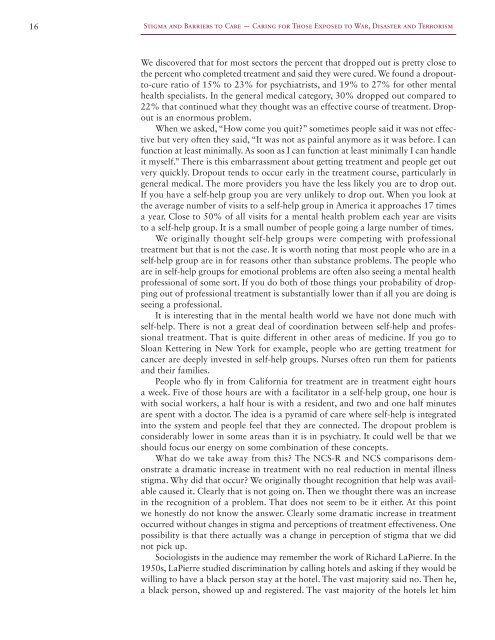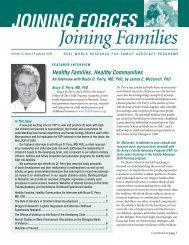stigma and barriers to care - Uniformed Services University of the ...
stigma and barriers to care - Uniformed Services University of the ...
stigma and barriers to care - Uniformed Services University of the ...
Create successful ePaper yourself
Turn your PDF publications into a flip-book with our unique Google optimized e-Paper software.
16<br />
Stigma <strong>and</strong> Barriers <strong>to</strong> Care — Caring for Those Exposed <strong>to</strong> War, Disaster <strong>and</strong> Terrorism<br />
We discovered that for most sec<strong>to</strong>rs <strong>the</strong> percent that dropped out is pretty close <strong>to</strong><br />
<strong>the</strong> percent who completed treatment <strong>and</strong> said <strong>the</strong>y were cured. We found a dropout<strong>to</strong>-cure<br />
ratio <strong>of</strong> 15% <strong>to</strong> 23% for psychiatrists, <strong>and</strong> 19% <strong>to</strong> 27% for o<strong>the</strong>r mental<br />
health specialists. In <strong>the</strong> general medical category, 30% dropped out compared <strong>to</strong><br />
22% that continued what <strong>the</strong>y thought was an effective course <strong>of</strong> treatment. Dropout<br />
is an enormous problem.<br />
When we asked, “How come you quit” sometimes people said it was not effective<br />
but very <strong>of</strong>ten <strong>the</strong>y said, “It was not as painful anymore as it was before. I can<br />
function at least minimally. As soon as I can function at least minimally I can h<strong>and</strong>le<br />
it myself.” There is this embarrassment about getting treatment <strong>and</strong> people get out<br />
very quickly. Dropout tends <strong>to</strong> occur early in <strong>the</strong> treatment course, particularly in<br />
general medical. The more providers you have <strong>the</strong> less likely you are <strong>to</strong> drop out.<br />
If you have a self-help group you are very unlikely <strong>to</strong> drop out. When you look at<br />
<strong>the</strong> average number <strong>of</strong> visits <strong>to</strong> a self-help group in America it approaches 17 times<br />
a year. Close <strong>to</strong> 50% <strong>of</strong> all visits for a mental health problem each year are visits<br />
<strong>to</strong> a self-help group. It is a small number <strong>of</strong> people going a large number <strong>of</strong> times.<br />
We originally thought self-help groups were competing with pr<strong>of</strong>essional<br />
treatment but that is not <strong>the</strong> case. It is worth noting that most people who are in a<br />
self-help group are in for reasons o<strong>the</strong>r than substance problems. The people who<br />
are in self-help groups for emotional problems are <strong>of</strong>ten also seeing a mental health<br />
pr<strong>of</strong>essional <strong>of</strong> some sort. If you do both <strong>of</strong> those things your probability <strong>of</strong> dropping<br />
out <strong>of</strong> pr<strong>of</strong>essional treatment is substantially lower than if all you are doing is<br />
seeing a pr<strong>of</strong>essional.<br />
It is interesting that in <strong>the</strong> mental health world we have not done much with<br />
self-help. There is not a great deal <strong>of</strong> coordination between self-help <strong>and</strong> pr<strong>of</strong>essional<br />
treatment. That is quite different in o<strong>the</strong>r areas <strong>of</strong> medicine. If you go <strong>to</strong><br />
Sloan Kettering in New York for example, people who are getting treatment for<br />
cancer are deeply invested in self-help groups. Nurses <strong>of</strong>ten run <strong>the</strong>m for patients<br />
<strong>and</strong> <strong>the</strong>ir families.<br />
People who fly in from California for treatment are in treatment eight hours<br />
a week. Five <strong>of</strong> those hours are with a facilita<strong>to</strong>r in a self-help group, one hour is<br />
with social workers, a half hour is with a resident, <strong>and</strong> two <strong>and</strong> one half minutes<br />
are spent with a doc<strong>to</strong>r. The idea is a pyramid <strong>of</strong> <strong>care</strong> where self-help is integrated<br />
in<strong>to</strong> <strong>the</strong> system <strong>and</strong> people feel that <strong>the</strong>y are connected. The dropout problem is<br />
considerably lower in some areas than it is in psychiatry. It could well be that we<br />
should focus our energy on some combination <strong>of</strong> <strong>the</strong>se concepts.<br />
What do we take away from this The NCS-R <strong>and</strong> NCS comparisons demonstrate<br />
a dramatic increase in treatment with no real reduction in mental illness<br />
<strong>stigma</strong>. Why did that occur We originally thought recognition that help was available<br />
caused it. Clearly that is not going on. Then we thought <strong>the</strong>re was an increase<br />
in <strong>the</strong> recognition <strong>of</strong> a problem. That does not seem <strong>to</strong> be it ei<strong>the</strong>r. At this point<br />
we honestly do not know <strong>the</strong> answer. Clearly some dramatic increase in treatment<br />
occurred without changes in <strong>stigma</strong> <strong>and</strong> perceptions <strong>of</strong> treatment effectiveness. One<br />
possibility is that <strong>the</strong>re actually was a change in perception <strong>of</strong> <strong>stigma</strong> that we did<br />
not pick up.<br />
Sociologists in <strong>the</strong> audience may remember <strong>the</strong> work <strong>of</strong> Richard LaPierre. In <strong>the</strong><br />
1950s, LaPierre studied discrimination by calling hotels <strong>and</strong> asking if <strong>the</strong>y would be<br />
willing <strong>to</strong> have a black person stay at <strong>the</strong> hotel. The vast majority said no. Then he,<br />
a black person, showed up <strong>and</strong> registered. The vast majority <strong>of</strong> <strong>the</strong> hotels let him




